Period Name Description -300 BC Jomon The early Japanese were gatherers, hunters and fishers. 300 BC-300 Yayoi The introduction of rice agriculture begins the development of a social hierarchy and hundreds of small countries that started to unify into larger countries. 300-538 Kofun 300 Japan is for the first time more or less united. Large tombs (kofun) were built for the deceased leaders. 538-710 Asuka 538/552 Introduction of Buddhism.
604 Prince Shotoku's Constitution of seventeen articles is promulgated.
645 The Taika reform is introduced. The Fujiwara era starts. 710-784 Nara 710 Nara becomes the first permanent capital.
784 The capital moves to Nagaoka. 794-1185 Heian 794 The capital moves to Heian (Kyoto).
1016 Fujiwara Michinaga becomes regent.
1159 The Taira clan under Taira Kiyomori takes over the power after the Heiji war.
1175 The Buddhist Jodo sect (Pure land sect) is introduced.
1180-85 In the Gempei War, the Minamoto clan puts an end to Taira supremacy. 1192-1333 Kamakura 1191 The Zen sect is introduced.
1192 Minamoto Yoritomo is appointed shogun and establishes the Kamakura government.
1221 The Jokyu Disturbance ends a struggle between Kamakura and Kyoto resulting in the supremacy of the Hojo regents in Kamakura.
1232 A legal code, the Joei Shikimoku, is promulgated.
1274 and 1281 The Mongols try to invade Japan twice, but fail mainly because of bad weather conditions.
1333 The Kamakura bakufu falls. 1338-1573 Muromachi 1334 Kemmu restoration: the emperor restores power over Japan.
1336 Ashikaga Takauji captures Kyoto.
1337 The emperor flees and establishes the Southern court in Yoshino.
1338 Takauji establishes the Muromachi government and a second emperor in Kyoto (Northern court).
1392 Unification of the Southern and Northern courts.
1467-1477 Onin war.
1542 Portuguese introduce firearms and Christianity to Japan.
1568 Nobunaga enters Kyoto.
1573 The Muromachi Bakufu falls. 1573-1603 Azuchi
Momoyama 1575 The Takeda clan is defeated in the battle of Nagashino.
1582 Nobunaga is murdered and succeeded by Toyotomi Hideyoshi.
1588 Hideyoshi confiscates the weapons of farmers and religious institutions in the "Sword Hunt".
1590 Japan is reunited after the fall of Odawara (Hojo).
1592-98 Unsuccessful invasion of Korea.
1598 Death of Hideyoshi.
1600 Tokugawa Ieyasu defeats his rivals in the battle of Sekigahara. 1603 - 1867 Edo 1603 Ieyasu is appointed shogun and establishes the Tokugawa government in Edo (Tokyo).
1614 Ieyasu intensifies persecution of Christianity.
1615 The Toyotomi clan is destroyed after Ieyasu captures Osaka Castle.
1639 Almost complete isolation of Japan from the rest of the world.
1688-1703 Genroku era: popular culture flourishes.
1792 The Russians unsuccessfuly try to establish trade relations with Japan.
1854 Commodore Matthew Perry forces the Japanese government to open a limited number of ports for trade. 1868-1912 Meiji 1868 Meiji restoration.
1872 First railway line between Tokyo and Yokohama.
1889 The Meiji Constitution is promulgated.
1894-95 Sino-Japanese War.
1904-05 Russo-Japanese War.
1910 Annexation of Korea.
1912 Death of emperor Meiji. 1912-1926 Taisho 1914-18 Japan joins allied forces in WW1.
1923 The Great Kanto Earthquake devastates Tokyo and Yokohama. 1926-1989 Showa 1931 Manchurian Incident.
1937 Second Sino-Japanese War starts.
1941 Pacific War starts.
1945 Japan surrenders after two atomic bombs are dropped over Hiroshima and Nagasaki.
1946 The new constitution is promulgated.
1952 The Allied Occupation of Japan ends.
1956 Japan becomes member of the UN.
1972 Normalization of relations to China.
1973 Oil crisis. 1989- Heisei 1993 The LDP loses its majority in the diet.
1995 The Great Hanshin Earthquake hits Kobe.
Sarin Gas attack in the Tokyo subway by AUM sect.
2009 The Democratic Party of Japan becomes the ruling party.
2011 Great East Japan Earthquake
The Jōmon period (縄文時代 Jōmon jidai?) is the time in Prehistoric Japan from about 12,000 BC[1] and in some cases cited as early as 14,500 BC[2] to about 300 BC, when Japan was inhabited by a hunter-gatherer culture which reached a considerable degree ofsedentism and cultural complexity.
The name "cord-marked" was first applied by the American scholar Edward S. Morse who discovered sherds of pottery in 1877 and subsequently translated it into Japanese as jōmon.[3] The pottery style characteristic of the first phases of Jōmon culture was decorated by impressing cords into the surface of wet clay. This pottery, dated to around 16,000 years ago, is perhaps the oldest in the world (pottery nearly as old has been found in southern China, the Russian Far East, and Korea).[4] The period was rich in tools and jewelry made from bone, stone, shell, and antler; pottery figurines and vessels; and lacquered wood.[5][6][7] The Jōmon culture is often compared to pre-Columbian cultures of Pacific Northwest North America because in both regions cultural complexity developed within a primarily hunting-gathering context (with limited use of horticulture).[8][9]Chronology[edit]The very long—approximately 14,000 years—Jōmon period is conventionally divided into a number of phases: Incipient, Initial, Early, Middle, Late and Final, with the phases getting progressively shorter. Most dates for the change of phase are broadly agreed, but dates given for the start of the Incipient phase still vary rather considerably, from about 14,000 BC to 10,500 BC. The fact that this entire period is given the same name by archaeologists should not be taken to mean that there was not considerable regional and temporal diversity; the chronological distance between the earliest Jōmon pottery and that of the more well-known Middle Jōmon period is about twice as long as the span separating the building of the Great Pyramid of Giza from the 21st century.
Dating of the Jōmon sub-phases is based primarily upon ceramic typology, and to a lesser extent radiocarbon dating.
Incipient and Initial Jōmon (14,000–4,000 BC)[edit]Traces of Paleolithic culture, mainly stone tools, occur in Japan from around 30,000 BC onwards. The earliest "Incipient Jōmon" phase began while Japan was still linked to continental Asia as a narrow peninsula.[10] As the glaciers melted following the end of the Last glacial period (approximately 12,000 years ago), sea levels rose, separating the Japanese archipelago from the Asian mainland; the closest point (in Kyushu) about 190 km (120 miles) from the Korean Peninsula is near enough to be intermittently influenced by continental developments but far enough removed for the peoples of the Japanese islands to develop their own ways.
Within the archipelago the vegetation was transformed by the end of the Ice Age. In southwestern Honshu, Shikoku, and Kyushu, broadleaf evergreen trees dominated the forests, whereas broadleaf deciduous trees and conifers were common in north-eastern Honshu and southern Hokkaido. Many native tree species, such as beeches, buckeyes, chestnuts, and oaks produced edible nuts and acorns. These provided abundant sources of food for humans and animals.
In the northeast, the plentiful marine life carried south by the Oyashio current, especially salmon, was an additional major source of food. Settlements along both the Sea of Japan and the Pacific Ocean subsisted on immense amounts of shellfish, leaving distinctive middens (mounds of discarded shells and other refuse) that are now prized sources of information for archeologists. Other sources of food meriting special mention include deer, wild boar, yam-like tubers and other wild plants, and freshwater fish. Supported by the highly productive deciduous forests and an abundance of seafood, the population was concentrated in central and northern Honshu, but Jōmon sites range from Hokkaido to the Ryukyu Islands.
Earliest pottery[edit]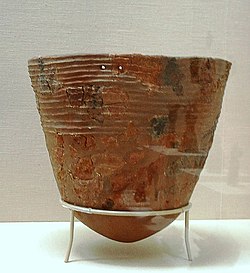
 Incipient Jōmon Pottery (14,000–8000 BC) Tokyo National Museum, Japan.
Incipient Jōmon Pottery (14,000–8000 BC) Tokyo National Museum, Japan.
It currently appears that the earliest pottery in the world may have been made in Japan, at or before the start of the Incipient Jōmon period. In 1998 a number of small fragments were found at the Odai Yamamoto I site, which have been dated to the 14th Millennium BC; subsequently more pottery of the same age was found at other sites such as Kamikuroiwa and Fukui Cave.[10][11][12]Archaeologist Junko Habu claims that "The majority of Japanese scholars believed, and still believe, that pottery production was first invented in mainland Asia and subsequently introduced into the Japanese archipelago",[12] however at present it appears that pottery emerged at roughly the same time in Japan, the Amur River basin of far eastern Russia, and China.[13]The first Jōmon Pottery is characterized by the cord-marking that gives the period its name, and has now been found in large numbers of sites. The pottery of the whole period has been classified by archaeologists into some 70 styles, with many more local varieties of the styles.[3] The antiquity of Jōmon Pottery was first identified after World War II, through radiocarbon datingmethods.[6][14] The earliest vessels were mostly smallish round-bottomed bowls 10–50 cm high that are assumed to have been used for boiling food, and perhaps storing it beforehand. They belonged to hunter-gatherers and the size of the vessels may have been limited by a need for portability; as later bowls increase in size, this is taken to be a sign of an increasingly settled pattern of living. These types continued to develop, with increasingly elaborate patterns of decoration, undulating rims, and flat bottoms so that they could stand on a surface.[15]The manufacture of pottery typically implies some form of sedentary life due to the fact that pottery is heavy, bulky, and fragile and thus generally useless to hunter-gatherers who are constantly on the move in search of food; however this does not seem to have been the case with the first Jōmon people, who perhaps numbered some 20,000 over the whole archipelago.[10] It seems that food sources were so abundant in the natural environment of the Japanese islands that it could support fairly large, semi-sedentary populations. The Jōmon people used chipped stone tools, ground stone tools, traps, and bows, and were evidently skillful coastal and deep-water fishermen.
Population expansion[edit]By the end of the Incipient Jōmon phase, around 8,000 BC, a semi-sedentary lifestyle apparently led to an increase in population density, so that the subsequent phase, the Initial Jōmon, exhibits some of the highest densities known for foraging populations.[16] Genetic mapping studies by Cavalli-Sforza have shown a pattern of genetic expansion from the area of the Sea of Japan towards the rest of eastern Asia. This appears as the third principal component of genetic variation in Eurasia (after the "Great expansion" from the African continent, and a second expansion from the area of Northern Siberia), which suggests geographical expansion during the early Jōmon period.[17] These studies also suggest that the Jōmon demographic expansion may have reached America along a path following the Pacific coast.[18]Early Jōmon (4,000–2500 BC)[edit]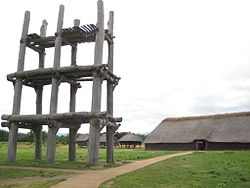
 Reconstructed buildings in the Sannai-Maruyama site, Aomori PrefectureThe Early and Middle Jōmon periods saw an explosion in population, as indicated by the number of settlements from this period. These two periods occurred during the Holocene Climatic Optimum (between 4000 BC and 2000 BC), when temperatures reached several degrees Celsius higher than the present.
Reconstructed buildings in the Sannai-Maruyama site, Aomori PrefectureThe Early and Middle Jōmon periods saw an explosion in population, as indicated by the number of settlements from this period. These two periods occurred during the Holocene Climatic Optimum (between 4000 BC and 2000 BC), when temperatures reached several degrees Celsius higher than the present.
Middle Jōmon (2500-1500 BC)[edit]Highly ornate pottery dogū figurines and vessels, such as the so-called "flame style" vessels, and lacquered wood objects remain from that time. Interestingly, although the ornamentation of pottery increased over time, the ceramic fabric always remained quite coarse.
The degree to which horticulture or small-scale agriculture was practiced by Jōmon people is debated, but there is evidence to suggest that arboriculturewas practiced in the form of tending groves of nut- and lacquer-producing trees.[19][20]This period saw a rise in complexity in the design of pit houses, the most commonly used method of housing at the time,[21] with some even having stone paved floors.
Late and Final Jōmon (1500-900/300 BC)[edit]After 1500 BC, the climate cooled, and populations seem to have contracted dramatically. Comparatively few archaeological sites can be found after 1500 BC.
During the Final Jōmon period, a slow shift was taking place in western Japan: steadily increasing contact with the Korean peninsula eventually led to the establishment of Korean-type settlements in western Kyushu, beginning around 900 BC. The settlers brought with them new technologies such as wet rice farming and bronze and iron metallurgy, as well as new pottery styles similar to those of the Mumun culture. The settlements of these new arrivals seem to have coexisted with those of the Jōmon for around a thousand years. The new farming culture is called Yayoi after an archaeological site near Tokyo.[6]The Final Jōmon is succeeded by the Yayoi period (ca. 300 BC-AD 300) outside Hokkaido; within Hokkaido the Jōmon is succeeded by the Zoku-Jōmon (post-Jōmon) or Epi-Jōmon period. The Zoku-Jōmon culture is in turn succeeded by the Satsumon culture around the 7th century.
Yayoi Period The Yayoi period (弥生時代 Yayoi jidai) is a prehistoric period of Japan, usually dated from 300 BCE to ca 300 CE, during which wet-rice agriculture and the use of bronze and iron first appeared in Japan. The term Yayoi refers to a certain characteristic pottery discovered in the Yayoi quarter of Bunkyō Ward in Tōkyō, in 1884. It was preceded by the Jōmon Period, which was distinguished by a hunting and gathering way of life, and was followed by the Kofun Period, distinguished by the construction of of large tumuli or grave mounds (kofun) and the formation of an incipient state.The culture of the Yayoi Era is characterized by irrigated rice cultivation and the use bronze and iron artifacts. There was considerable contact with China and Korea during this period, and it can be assumed that those technical innovations, which spread north from Kyūshū, are the results of continental influence. The Yayoi population, living in small communities, experienced social stratification, and by the Late Yayoi (ca 100-ca 300 CE) Japan was divided into a number of small political units (kuni) controlled by local chieftains.
The Yayoi period (弥生時代 Yayoi jidai) is a prehistoric period of Japan, usually dated from 300 BCE to ca 300 CE, during which wet-rice agriculture and the use of bronze and iron first appeared in Japan. The term Yayoi refers to a certain characteristic pottery discovered in the Yayoi quarter of Bunkyō Ward in Tōkyō, in 1884. It was preceded by the Jōmon Period, which was distinguished by a hunting and gathering way of life, and was followed by the Kofun Period, distinguished by the construction of of large tumuli or grave mounds (kofun) and the formation of an incipient state.The culture of the Yayoi Era is characterized by irrigated rice cultivation and the use bronze and iron artifacts. There was considerable contact with China and Korea during this period, and it can be assumed that those technical innovations, which spread north from Kyūshū, are the results of continental influence. The Yayoi population, living in small communities, experienced social stratification, and by the Late Yayoi (ca 100-ca 300 CE) Japan was divided into a number of small political units (kuni) controlled by local chieftains.
New technologies
The Yayoi people continued to use some of the tools of the Jōmon Era, such as chipped stone tools, arrowheads, axes, and small knife-like blades; stone axes and adzes of the Yayoi Period however were mostly polished and large in size and not only used for chopping and cutting, but also to till the soil. A special polished blade (石包丁 or 石庖丁 ishibōchō) was developed to reap rice. Other polished-stone tools included columnar chisels and flat plane blades used for making wooden objects such as hoes and spades, weaving implements, containers, and utensils. Some wooden bowls from theKarako-Kagi site (唐古・鍵遺跡) in Tawaramoto, Nara Prefecture are known to have been turned at a lathe (轆轤 rokuro). Yayoi pottery consisted mainly of long-necked jars, wide-mouthed pots, deep basins, and pedestal bowls. Most of these vessels bore geometric patterns and designs. In contrast to the Jōmon people, the Yayoi people knew how to smelt iron and forge simple implements, like containers, weapons, and farming and craft tools.
Some items, particularly, bronze mirrors, were obtained from the continent, but by the late Yayoi the Japanese were able to produce bronze mirrors, bronze bells (銅鐸 dōtaku), and bronze weapons themselves. Sandstone molds for casting these objects were found in abundance in northern Kyūshū and the Kinai Region (畿内, Kyōto-Nara-Ōsaka). Other techniques involved the production of jasper and jademagatama (勾玉, curved, comma-shaped beads).

Wooden mortar exhibited at the Tokyo National Museum
Yayoi life
Cloth woven from flax and paper-mulberry fibers was the basic clothing material. Men wrapped length of cloths and slipped them over their head, while both women and men woremagatama beads strung into necklaces and bracelets, as well as rings made of shells or bronze. As the Yayoi society changed from hunting and gathering to rice cultivating, the diet changed fundamentally. Rice paddies were enclosed by dikes and irrigation techniques refined. Rice was supplemented with other crops such as millet, beans, and gourds. Most Yayoi settlements were established along large rivers and coastal planes or on terraces. Pit houses, built close together, were still simple structures, with earthen floors and thatched roofs. The settlements had communal granaries and wells, and the paddies were usually located nearby.
Yayoi beliefs
It is very likely that the beliefs of the agricultural Yayoi society were quite different from those of the Jōmon society. Artifacts recovered suggest a variety of religious festivals honouring different deities. Bronze bells, daggers, and spearheads seem to have been used exclusively for ceremonial purposes, while bronze mirrors were also used as ritual objects. Divination was carried out by searing deer bones. The Yayoi people developed the practice of secondary burial; the bones were exhumed, washed, probably painted with red ocher, and placed in jars. The jars were then buried in large pits, some of which were surrounded by moats. Mirrors, beads, and bronze weapons were buried with the dead in dolmen burials.
Late Yayoi Society
Japan was first mentioned in Chinese records, such as the Book of the Later Han (Hou Han Shu), compiled by Fan Ye and others in the fifth century, stating that the land of Na (奴国 Nakoku or Na-no-kuni), an early local territory close to present-day Fukuoka, had been granted an imperial seal made of gold by Emperor Guangwu of Han in 57 CE. Geographical notations of the Shan Hai Jing (山海經, “Classic of the Mountains and Seas”) mention Japan as Wō (倭) or Wa in Japanese. The Wei zhi (chin. 魏書 or 魏志, “Records of Wei”), which covers the period from 200-265), provides information on the Late Yayoi period, describing a highly stratified society in which wealthy landholders ruled over common people. The Wei zhi mentions a kingdom called Yamatai, also known as Yamataikoku (邪馬台国) or Yamaichikoku (邪馬壹國), that controlled some thirty other territories, each of them ruled by a “chieftain” or “king” as well as the mysterious “shaman Queen” Himiko (卑彌呼), who was chosen to rule the Kingdom of Wa after decades of civil war and who maintained relations with the Chinese court as well as the King of Silla (modern-day Korea). The Wei zhi further relates that the markets of Wa flourished, taxes were collected, and a system of punishment was prescribed for malefactors. All this indicates that the Yayoi society was fairly complex and well organised. Social, political, economic, and military specialization was powerfully developing and would herald the society of the succeeding Kofun Period.
Related links:
- Yayoi linked to Yangtze area (Japan Times)
- The Yayoi Years (Heritage of Japan)
- Eastern Japanese pottery during the Jomon-Yayoi transition: a study in forager-farmer transition (by Seiji Kobayashi, PDF)
- Japanese roots surprisingly shallow (Japan Times)
- Earlier Start for Japanese Rice Cultivation (ScienceNOW)
Kofun Period
| Period | Name | Description |
| -300 BC | Jomon | The early Japanese were gatherers, hunters and fishers. |
| 300 BC-300 | Yayoi | The introduction of rice agriculture begins the development of a social hierarchy and hundreds of small countries that started to unify into larger countries. |
| 300-538 | Kofun | 300 Japan is for the first time more or less united. Large tombs (kofun) were built for the deceased leaders. |
| 538-710 | Asuka | 538/552 Introduction of Buddhism. 604 Prince Shotoku's Constitution of seventeen articles is promulgated. 645 The Taika reform is introduced. The Fujiwara era starts. |
| 710-784 | Nara | 710 Nara becomes the first permanent capital. 784 The capital moves to Nagaoka. |
| 794-1185 | Heian | 794 The capital moves to Heian (Kyoto). 1016 Fujiwara Michinaga becomes regent. 1159 The Taira clan under Taira Kiyomori takes over the power after the Heiji war. 1175 The Buddhist Jodo sect (Pure land sect) is introduced. 1180-85 In the Gempei War, the Minamoto clan puts an end to Taira supremacy. |
| 1192-1333 | Kamakura | 1191 The Zen sect is introduced. 1192 Minamoto Yoritomo is appointed shogun and establishes the Kamakura government. 1221 The Jokyu Disturbance ends a struggle between Kamakura and Kyoto resulting in the supremacy of the Hojo regents in Kamakura. 1232 A legal code, the Joei Shikimoku, is promulgated. 1274 and 1281 The Mongols try to invade Japan twice, but fail mainly because of bad weather conditions. 1333 The Kamakura bakufu falls. |
| 1338-1573 | Muromachi | 1334 Kemmu restoration: the emperor restores power over Japan. 1336 Ashikaga Takauji captures Kyoto. 1337 The emperor flees and establishes the Southern court in Yoshino. 1338 Takauji establishes the Muromachi government and a second emperor in Kyoto (Northern court). 1392 Unification of the Southern and Northern courts. 1467-1477 Onin war. 1542 Portuguese introduce firearms and Christianity to Japan. 1568 Nobunaga enters Kyoto. 1573 The Muromachi Bakufu falls. |
| 1573-1603 | Azuchi Momoyama | 1575 The Takeda clan is defeated in the battle of Nagashino. 1582 Nobunaga is murdered and succeeded by Toyotomi Hideyoshi. 1588 Hideyoshi confiscates the weapons of farmers and religious institutions in the "Sword Hunt". 1590 Japan is reunited after the fall of Odawara (Hojo). 1592-98 Unsuccessful invasion of Korea. 1598 Death of Hideyoshi. 1600 Tokugawa Ieyasu defeats his rivals in the battle of Sekigahara. |
| 1603 - 1867 | Edo | 1603 Ieyasu is appointed shogun and establishes the Tokugawa government in Edo (Tokyo). 1614 Ieyasu intensifies persecution of Christianity. 1615 The Toyotomi clan is destroyed after Ieyasu captures Osaka Castle. 1639 Almost complete isolation of Japan from the rest of the world. 1688-1703 Genroku era: popular culture flourishes. 1792 The Russians unsuccessfuly try to establish trade relations with Japan. 1854 Commodore Matthew Perry forces the Japanese government to open a limited number of ports for trade. |
| 1868-1912 | Meiji | 1868 Meiji restoration. 1872 First railway line between Tokyo and Yokohama. 1889 The Meiji Constitution is promulgated. 1894-95 Sino-Japanese War. 1904-05 Russo-Japanese War. 1910 Annexation of Korea. 1912 Death of emperor Meiji. |
| 1912-1926 | Taisho | 1914-18 Japan joins allied forces in WW1. 1923 The Great Kanto Earthquake devastates Tokyo and Yokohama. |
| 1926-1989 | Showa | 1931 Manchurian Incident. 1937 Second Sino-Japanese War starts. 1941 Pacific War starts. 1945 Japan surrenders after two atomic bombs are dropped over Hiroshima and Nagasaki. 1946 The new constitution is promulgated. 1952 The Allied Occupation of Japan ends. 1956 Japan becomes member of the UN. 1972 Normalization of relations to China. 1973 Oil crisis. |
| 1989- | Heisei | 1993 The LDP loses its majority in the diet. 1995 The Great Hanshin Earthquake hits Kobe. Sarin Gas attack in the Tokyo subway by AUM sect. 2009 The Democratic Party of Japan becomes the ruling party. 2011 Great East Japan Earthquake |











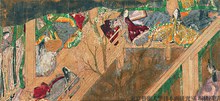
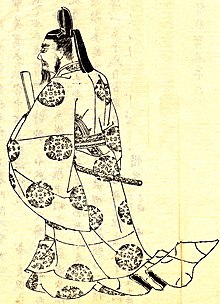

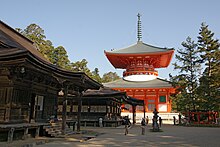
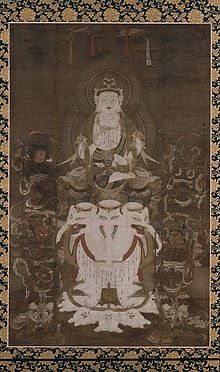
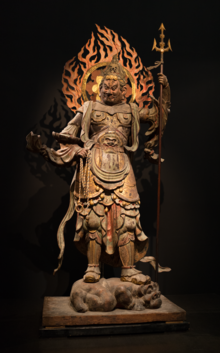
I am very fascinated with what you make in your article, I strongly agree.
ReplyDeleteLet me put my website as a link
http://alapbangla.com/user.php?login=golbet88&view=history
https://dzone.com/users/2987601/jennymeng.html?sort=links
http://golbet88.webnode.com/l/dapatkan-suasana-aman-saat-bermain-agen-bola-online-di-golbet88/
http://golbet88.web.wox.cc/blog
https://www.smore.com/37crp-golbet88-agen-bola-online-indonesia
very good, and I really like your article, and deeply inspired me I want to give other information with this website
ReplyDeleteBandar 66 Online